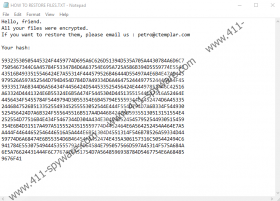RegretLocker Ransomware Removal Guide
What has happened that allowed RegretLocker Ransomware to slither into your Windows operating system? Were you tricked into downloading malware using a corrupted downloader found on an unreliable website? Did you open a malicious file that led to the execution of the threat after receiving a strange email message? Were known security and software vulnerabilities left unpatched? Did you leave your RDP channels wide open for cyberattackers? Whatever has led to the invasion of malware, we hope that you will take better care of your system in the future. Know that even if you delete RegretLocker Ransomware successfully, hundreds of other infections could try to attack if you do not figure out how to secure your operating system. A few of them include Fireee Ransomware, YAYA Ransomware, or CVC Ransomware. Ransomware infections are definitely very active these days, and the only way to guard yourself against them is to ensure full-time protection.
You can confirm that you need to remove RegretLocker Ransomware from your system if you can see the “.mouse” extension pinned to your personal files’ names. These could be videos and music files, photos, archives, and documents. Everything that is unique and, quite possibly, created by you. The purpose here is to corrupt files that matter because if RegretLocker Ransomware encrypted files that could be replaced or were inconsequential, victims would just remove malware and move on. However, if the threat manages to corrupt sensitive and valuable files, victims might be willing to obey the demands. These demands are introduced using the file called “HOW TO RESTORE FILES.TXT,” and copies of this file should be dropped next to the corrupted files. The message represented via this file informs: “All your files were encrypted. If you want to restore them, please email us: petro@ctemplar.com.” Should you send an email to cybercriminals? Absolutely, you should not. If you do it, we can only guess what would happen next.
The first order of business for the attackers behind RegretLocker Ransomware is to get your money, and they are likely to inform you that a decryptor exists. The entire infection was created just so that the attackers could sell you a decryptor, but who knows if it would fall into your hands? Cybercriminals are not known for keeping their promises or for conducting fair business. They are known for deception and theft, and if you think that you would get a decryptor by paying a ransom, we suggest thinking again. If you feel like you have no other option, please do not communicate with the cybercriminals via your normal email account. Create a new one. If you are planning on paying the ransom, think about all cons and pros first. Remember that the chances of you getting nothing are much higher than your chances of obtaining a decryptor. Luckily, a lot of Windows users these days choose external and virtual backups to store copies of personal files. If you are one of these users, you can replace the encrypted files as soon as you remove RegretLocker Ransomware.
If you are able to locate and identify the executable of RegretLocker Ransomware, you can delete this malware manually. However, the location of this file could be completely random, and while we give a list of potential locations in the guide below, there is no doubt that not everyone will be able to find and remove this malware manually. That is not a huge problem. Especially since it is also important to solve the issue of Windows security. Or lack thereof. Are you interested in employing anti-malware software? We certainly recommend that you install it because it can automatically delete RegretLocker Ransomware and also strengthen the security of your system. If you are going to remove the threat manually, your system’s security will not be strengthened, and you will need to figure it out separately. Why waste time. Implement reliable anti-malware software and be done with the threat. Afterward, replace the corrupted files if you have backup copies that can act as replacements.
How to delete RegretLocker Ransomware
- Delete all recently downloaded suspicious files. A few locations to check:
- %USERPROFILE%\Desktop
- %USERPROFILE%\Downloads
- %TEMP%
- Delete the file named HOW TO RESTORE FILES.TXT (eliminate all copies).
- Empty Recycle Bin and then quickly install a trusted malware scanner.
- Run a full system scan to check for leftovers.
RegretLocker Ransomware Screenshots:


